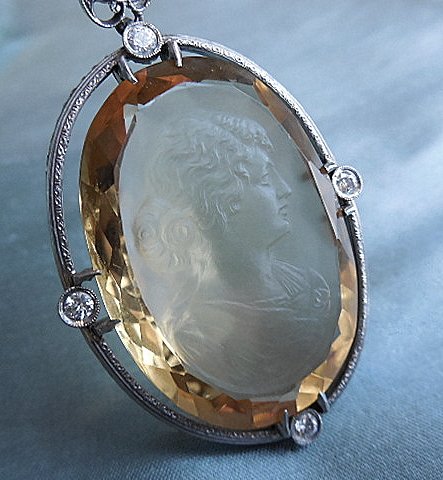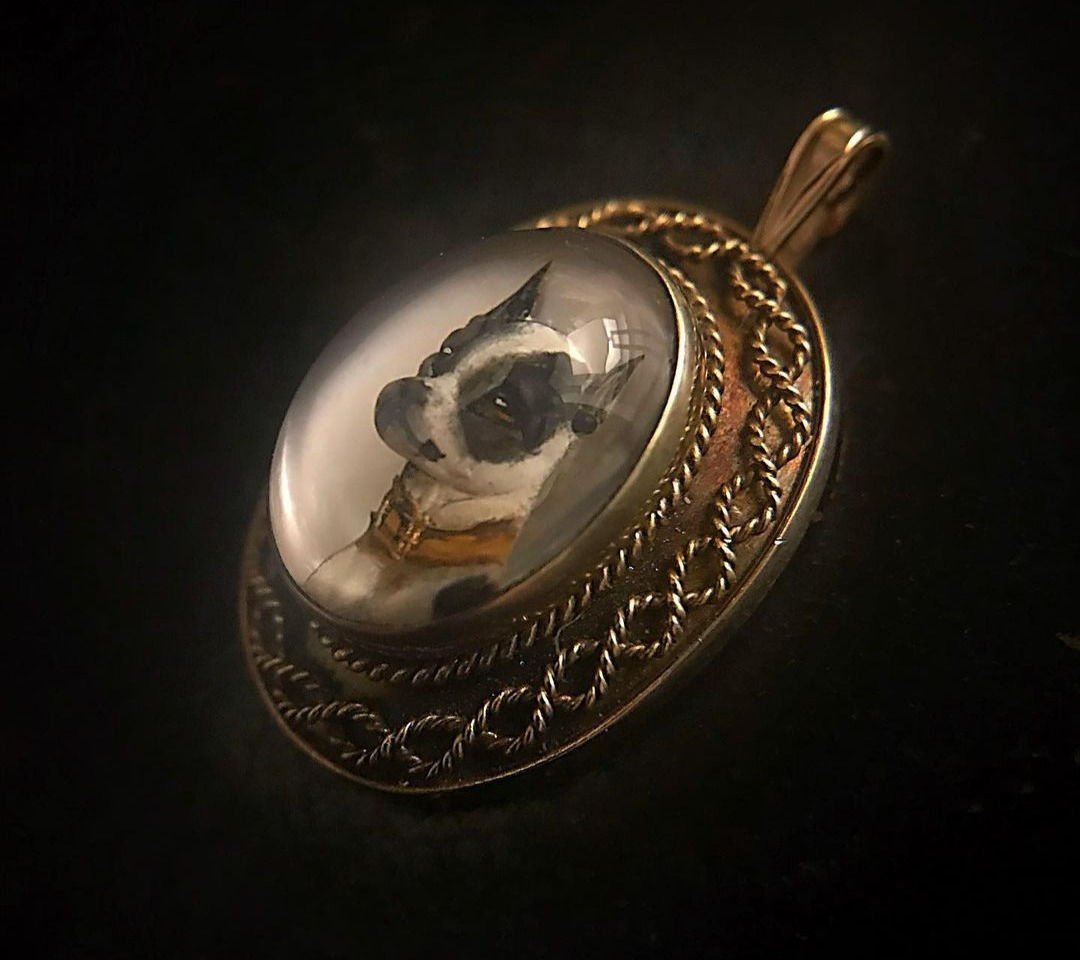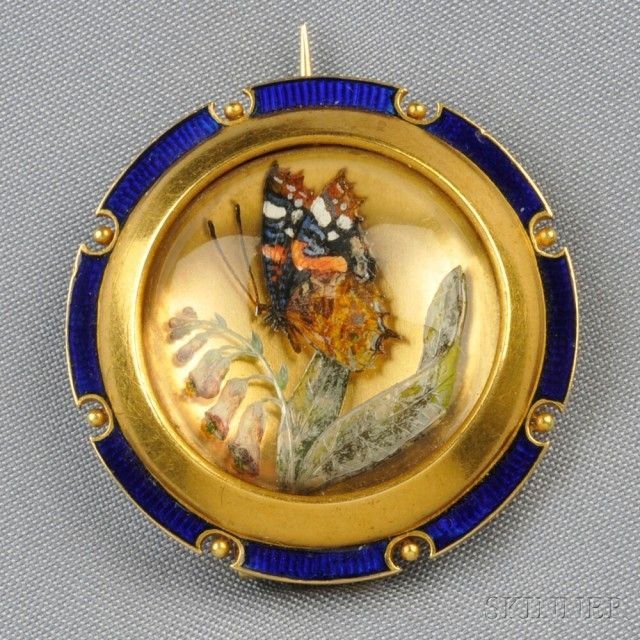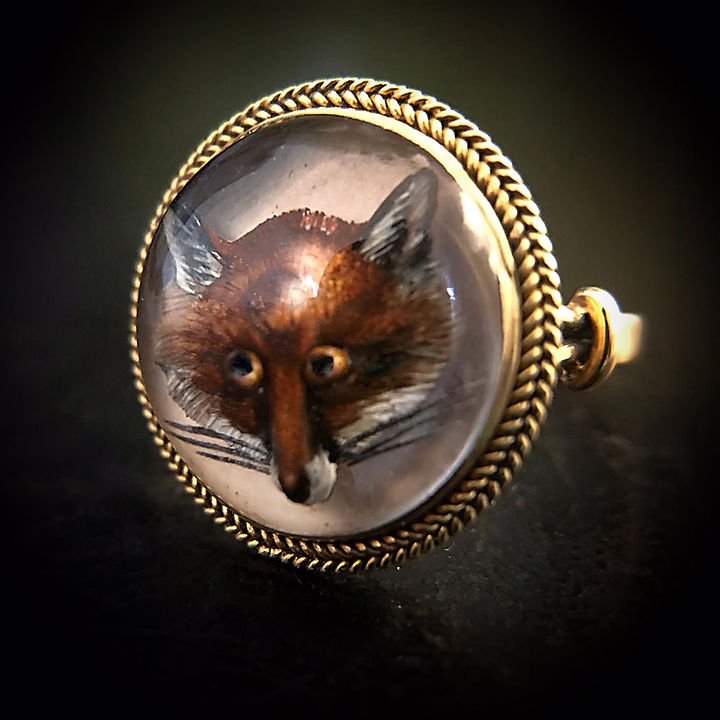by Ena Mulavdic
Jewellery design is one of the most captivating fields within the arts and crafts. The vast array of styles, techniques, and the diverse use of materials and colours, not to mention the gemstones that infuse man-made creations with the raw beauty of nature, enchants anyone who dares to explore the boundless world of jewellery.
In this article, we will delve into one of the most intricate techniques, practiced for over 8,000 years: the art of carving and engraving gemstones, with a special focus on reverse carving or negative intaglio. Gem engraving, whether for use as seals or as objects of adornment, is one of the oldest art forms known to humankind.
The art of gem engraving can be categorised into two primary types: cameo and intaglio (see figure 1). Additionally, there is an intermediary technique often referred to as 'chevet' (or 'cheve', 'curvette', 'cuvette', or 'dished' in the UK), where the figure is carved in relief within a concave depression, typically into the table of a faceted gemstone (see figure 2). In this method, the highest part of the finished cameo remains level with the original flat surface. This style of engraving is associated with the modern art era, particularly the early 20th century.
Figure 1. Intaglio and cameo - the oldest forms of engraved gems
Figure 2. An example of ‘chevet’ technique
In contrast, a cameo features a subject sculpted in relief, raised above the surface of the gem (see figure 3). Often, cameos are created using bicoloured or multicoloured gemstones, where the natural structure and colour variations of the stone are skillfully utilised to enhance the definition and detail of the carving.
Figure 3. An example of cameo; A Roman onyx cameo with a bacchic scene, Imperial period, c. 1st century AD
The intaglio technique, the opposite of cameo, involves carving below the surface of the gem to create an inverse image (see figure 4). Details are achieved by varying the depth of the engraving. Interestingly, historical records do not indicate that intaglio artists used magnification tools during the carving process. This is likely because magnification would be impractical; the hands, cutting drills, and slurry of polishing compounds obscure the work in progress. As a result, intaglio artists must rely on touch, developing a finely tuned sense of the carving to achieve the desired design. Mastering this skill requires months of continuous practice, training the muscles to 'feel' the intricacies of the carved shapes, depths, and the contrast between polished and matte areas.
Figure 4. An example of intaglio; A Roman garnet ring-stone with Diomedes, Imperial period, c. late 1st century BC-1st century AD
The history of stone engraving is as ancient as organized societies themselves. It began when humanity reached a level of economic and social development that necessitated the sealing of property. The earliest attempts at stone engraving are closely tied to the history of seals, which likely first appeared between 6500 and 6000 B.C. in the Neolithic cities of Mesopotamia.
In keeping with humanity's tendency to mimic nature, it’s fascinating to note that the earliest seals were made by pressing worm-eaten wood into clay, creating unique patterns due to the random arrangement of the wood’s cavities (see figure 5). Given the importance of animalistic and religious symbols to ancient peoples, it’s logical to conclude that the first hand-carved engravings and intaglios were centered around these motifs.
Figure 5. Worm-eaten wood
The first significant group of seals was the 'cylinder seals' (see figure 6), dating back to around 3000 B.C. in the valleys of Mesopotamia. These seals were used to sign documents, seal goods for tax purposes, and even serve as trademarks on objects such as pottery. Their cylindrical shape was ideal for rolling across surfaces to seal items like bottles, jars, and other containers.
Figure 6. Neolithic Mesopotamian cylinder seal
During the periods of Ancient Greece and Rome, engraving reached unprecedented heights. Technical skill, imagination, and creativity combined to produce exquisitely executed works of glyptic art. The era between the death of Alexander the Great and the Roman conquest of Greece (323 BC - 139 BC) is particularly significant for innovations in jewellery design. For the first time, we see the evolution of the seal—often depicted as a scarab beetle—into the ring-stone. These engraved seals (see figure 7) were set into metal rings, marking the beginning of the signet ring era, a tradition that continues unbroken even today in 2022 AD.
Figure 7. Ancient Greek Rock Crystal Gold Swivel Signet Ring, Archaic period, circa 500 B.C.
Distinct from the traditional intaglio technique is a method known as reverse carving, or negative intaglio, which evolved from the ancient intaglio practice. In reverse carving, the reliefs or sculptures are carved from the reverse side of the gemstone, leaving the upper side intact (see figure 8). This contrasts with the intaglio technique, where the design is intended to be viewed from the same side on which it is carved.
Figure 8. An example of negative intaglio sculptures by ELIRD Jewellery
The negative intaglio technique holds a unique allure in jewellery design. Although engraving and intaglio are ancient practices, the first coloured jewellery pieces featuring negative intaglios emerged during the Victorian era, known as Essex Rock Crystal (see figure 9). These pieces are crafted from rock crystal cabochons—gems that are polished but not faceted—featuring polished domes with flat bases. The motif or figure is reverse carved into the flat base and then painted, creating the illusion of a three-dimensional object encapsulated within the cabochon when viewed from above. Notably, the front of the reverse-carved piece remains untouched.
Figure 9. Essex crystal reverse intaglio butterfly set in 18ct gold with a natural ruby and rose-cut diamond border converted from a pin to a pendant, c.1880
One of the earliest and most successful users of the negative intaglio technique was Thomas Cook in the 1860s. His works were sold by Lambeth & Co and Hancock's in London. Another prominent figure associated with this technique is William Essex (1784-1869), a remarkable painter, miniature artist, and a favourite of Queen Victoria. His popularity among the nobility is likely why crystal rock jewellery featuring painted negative intaglios was named after him. William Bishop Ford, a student of William Essex, is also notable for his contributions, including the famous 'fox head' (see figure 10) and other enamelled miniatures and painted negative intaglios created in the late 1800s. However, some researchers believe that the Belgian artist Emile Marius Pradier may have actually developed the negative intaglio technique.
Figure 10. Painted negative intaglio by William Bishop Ford, 19th century
The pioneers of the negative intaglio technique used a combination of oil and diamond dust, along with around 200 different steel tools, to carve their intricate designs. Once the intaglio sculpture was carefully crafted and painted in reverse by a skilled artisan, the flat side of the cabochon was typically placed onto gold foil and backed with a thin layer of plain mother-of-pearl. The tools used for painting the intaglios were often custom-made by the master himself, as they needed to be exceptionally fine, with brushes often as thin as a single hair. After the painting and intaglio processes were completed, the cabochon was ready to be mounted onto a piece of jewellery.
Common jewellery and objects featuring painted negative intaglio crystals included brooches, pendants, stick pins, cufflinks, studs, buttons, rings, and more. Essex negative intaglio crystals can be categorised by the themes depicted on them. The most frequently seen motifs in Essex crystal jewellery include animals (such as dogs, cats, racehorses, insects, birds, foxes, and owls), flowers, and nautical elements. The following section will showcase several examples of Essex crystal jewellery.
Today, the negative intaglio technique is rarely seen in jewellery, as it demands considerable time, knowledge, experience, and dedication. Nevertheless, when encountered, this technique continues to captivate and inspire those who witness its artistry. One of the most innovative contemporary jewellery artists, Wallace Chan, has made significant contributions to the negative intaglio technique through his extraordinary work. In 1987, he invented and patented the 'Wallace Cut' (see figure 11), a technique that established him as a master sculptor.
The 'Wallace Cut' is based on reverse thinking, precise calculations, gem faceting, and 360-degree intaglio, creating multiple reflections within the stone. To achieve this, Wallace Chan also invented specialized tools, modifying dental drills to perform the intricate work. He conducted the carving process in water to prevent heat and tension, which could damage the stone. This groundbreaking invention produces a mysterious fourfold reflection on a transparent stone from a single carved face at the stone's back.
Figure 11. The Wallace Cut
Jewellery artists and studios such as Irene Neuwirth, Francesca Villa, Sevan Bicakci, and Yaroslav Argentov continue to use the negative intaglio technique, a tradition deeply rooted in civilisation as one of the oldest art forms known to humankind.
When we began our jewellery business, we chose to incorporate the negative intaglio technique into our designs, as it perfectly aligned with our philosophy of jewellery design. Carving a sculpture from the reverse side of a transparent gemstone felt as though we were engraving the soul of the piece rather than just its physical form. This approach resonates with our mission to explore, accept, and transform our inner selves, striving to reach our full potential as human beings. The many possibilities of this revered technique are still waiting to be explored by diligent jewellery artists who are unafraid to research, share, learn, implement, and innovate.
REFERENCES
Fred L. Gray, Engraved gems: A Historical Perspective, Gemological Institute of America, USA, 1984
Southerland B.B., The Romance of Seals and Engraved Gems, Macmilian Publishing Co., New York, USA, 1965
King C.W., Handbook of Engraved Gems, 2nd edition, george Ball and Sons, London, England, 1885 Wiseman D.J., Cylinder Seals of Western Asia, Batchworth Press, London, England, 1956
LINKS
https://www.wallace-chan.com/innovations/
https://www.lyonandturnbull.com/news/article/essex-crystal/
https://www.antiqueanimaljewelry.com/post/essex-crystal-jewelry/
https://chatsworthlady.com/2016/05/24/antique-essex-crystal-jewelry-animals/
https://www.wilson55.com/news/essex-crystal/
https://www.silvermangalleries.com/gallery/main.php?g2_itemId=10451
Disclaimer: ELIRD does not own any of these images, excluding one (1) image on Figure 8. Please note that all images and copyrights belong to their original owners. no copyright infringement intended.













































